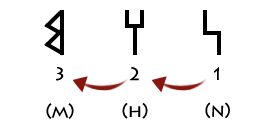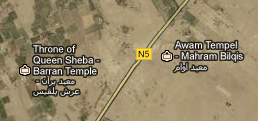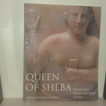Book of Mormon Geography: The place called Nahom
The Book of Mormon claims that the family of Lehi stopped at a location that was named Nahom. According to the book this is the location where a member of the group is buried after he passes away during their travel. The family travels eastward from this point for the remainder of their journey in the Arabian Peninsula.
This article addresses the following points:
 | Confirmed |
| An ancient area sounded out as NHM near a massive burial site on a major ancient trade route which connects the eastern Arabian shores to the north/south trade routes
An altar dated to 700 BC was found in southern Yemen bearing a Pablaean inscription of a place which is phonetically sounded out as NHM. It was found where the ancient Frankincense trail turns east near the massive burial site of the temple of Awwam. |  |
"Within the first part of the Book of Mormon there is a place which is named 'Nahom.' According to the book it is found a fair distance south from Jerusalem and is near the location where the family turns east in their journey. It is also the location where a member of the family ends up being buried. In 1988, an excavation in Yemen began that would later result in the discovery of an altar bearing the inscription of a location which is phonetically sounded out as 'NHM.' It is written in ancient Sabaean. Ancient Sabaean, like Hebrew, does not include written vowels. Unlike the Hebrew language, Sabaean does not have a written system for vowel indication. In Hebrew the sound of a vowel is determined by how the letters are used.
Currently the area is searchable on Google maps by the name 'Naham, Yemen.' Critics usually point out the vowel discrepancy, yet even with this one vowel variation the rest of the claim matches the location. Naham is found a fair distance south of Jerusalem. It is the area where the ancient Frankincense trail turns east, and the Awwam temple found about 1 km east of where the altar was found was used as a massive burial site during the claimed time period. None of this was known during the 1800s when the Book of Mormon was published. The excavation on the Awwam temple did not start until 1951 and the Frankincense trail was not mapped until 1997."
Source: www.EvidencesOfMormon.org/evidences/nahom-in-the-book-of-mormon.aspx
Images of the altar and other references are available at the source.
Part of the first book within the Book of Mormon records a journey of the family of Lehi who leaves Jerusalem and heads south. The book contains some very descriptive information about the journey through the Arabian Peninsula, including traveling times, landmarks, and location names. At one point the book identifies that the family stops at a place that was called Nahom. Several key events are recorded at and around this stop.
According to the Book of Mormon the family travels south making several stops along the way. One of the significant stops is a location where one of the members of the group, a man named Ishmael, dies. The following verse notes that Ishmael is then buried in Nahom. This indicates that the family camped near the location of Nahom at the time of Ishmael's death.
From here the family changes course and continues their journey eastward.
Nahom according to the Book of Mormon
The location of Nahom:
The location of Nahom is determined using the following verses in the Book of Mormon:
The family leaves Jerusalem and travels to the Red Sea which is south of Jerusalem in 1 Nephi 2:4-5:
"And it came to pass that he departed into the wilderness. And he left his house, and the land of his inheritance, and his gold, and his silver, and his precious things, and took nothing with him, save it were his family, and provisions, and tents, and departed into the wilderness.
And he came down by the borders near the shore of the Red Sea; and he traveled in the wilderness in the borders which are nearer the Red Sea; and he did travel in the wilderness with his family, which consisted of my mother, Sariah, and my elder brothers, who were Laman, Lemuel, and Sam."
A lot of events happen while the family is camped at this location. The journey doesn’t resume until 1 Nephi 16:12-13 at which point they travel south-southeast.
"And it came to pass that we did take our tents and depart into the wilderness, across the river Laman.
And it came to pass that we traveled for the space of four days, nearly a south-southeast direction, and we did pitch our tents again; and we did call the name of the place Shazer."
They camp here for a while and then begin their journey again in 1 Nephi 16:33:
"And it came to pass that we did again take our journey, traveling nearly the same course as in the beginning; and after we had traveled for the space of many days we did pitch our tents again, that we might tarry for the space of a time."
This is the camp where Ishmael passes away.
The burial site:
According to 1 Nephi 16:34 Ishmael passes away and is buried in Nahom:
"And it came to pass that Ishmael died, and was buried in the place which was called Nahom."
The journey eastward:
At the beginning of the next chapter the book identifies that the family travels eastward from this camp for the remainder of the journey in the Arabian Peninsula:
"And it came to pass that we did again take our journey in the wilderness; and we did travel nearly eastward from that time forth. And we did travel and wade through much affliction in the wilderness; ..."

One of three altars discovered at the Bar'an temple bearing the inscription of "NHM."
Courtesy of Roswitha and Roland Mosler from
Impetus In Mundum
The altars of NHM discovered in the temple of Bar'an:
A discovery in Yemen provides support for the name that is found in the Book of Mormon. In 1988 in Ma'rib, Yemen an excavation team began an excavation of the Bar'an temple. This site would produce three altars which bear the same inscription, identifying a place that coincides with the name found in the book. The inscription identified a place that is sounded out literally as NHM in English. A total of three altars bearing this inscription have now been found at this site.[1]
There is a common misconception about this altar's language. Many LDS apologists and critics use the Hebrew language to both defend and critique the inscription. The problem here is that the altar is not actually inscribed in Hebrew. It is written in an ancient language called Sabaean.[2] Like Hebrew, Sabaean does not have any characters to represent the common vowel sounds that we have in English (a, e, i, o, u). Hebrew gives you hints to the vowel sounds by the way that the consonants are used in a word. If you review the letters around where a vowel sound should be you can determine what it should sound like in Hebrew. Sabaean is different in that it does not contain any indication of what the vowel sounds should be.
Here's how this works: The inscription on the altar identifies a location which is written as seen below:

This specific altar has the word wrapped on the corner of the altar. At least one of the other altars has the word on a single side. This image comes from a photograph taken by Roswitha and Roland Mosler over at Impetus In Mundum and is used with permission.
Sabaean is written from right to left, which is the opposite way from how we read things in English. So to properly know how they pronounced this word we need to start reading it from the right side. We will number the characters in the order they would be read in this illustration to make it easier:

When you speak the first character in Sabaean, it makes the same sound as our English N makes (as in 'Nancy'). The second character makes the same sound as our H (as in 'hat'), and the third makes the same sound as our M (as in 'Mary'). Thus the word makes the sound "NHM." We know the H is not silent because the second character makes the sound of a voiceless H. This is the same h as found in 'hat,' home,' and 'helium.' Voiceless is a phonetic term used to describe if your larynx vibrates when saying the sound. For example, z and s make a similar sound in English, however, the s is voiceless and the z is voiced. If it was silent it would look like a three pointed trident in Sabaean.[3]
So thus we have the place of NHM which can be pronounced phonetically the same as Nahom, Naham, Nahum, and Nehem. Other scholars have claimed that it may be pronounced as Nihm and Nahm.
The altars date between 700 and 600 BC.[4] According to the Book of Mormon the family that buries Ishmael at Nahom left Jerusalem at about 600 BC.
Here is the full inscription according to The British Museum Press where they have translated the NHM as Nihm:
"Bi'athtar, son of Sawad from the tribe Naw' from Nihm, has dedicated to 'Almaqah Fari'at. By 'Athtar, by 'Almaqah and by dhat-Himyam. By Yada'il and by Ma'dikarib."[1]
The coincidental corroborative evidence of the NHM site:

A screenshot of
Google Maps from November 23rd, 2012 of the Bar'an and Awwam temple sites.
Even if we ignore the exact spelling of the name that is in the Book of Mormon, the other evidences that come from this section of scripture also align with this area of Yemen.
According to the Book of Mormon, Ishmael is buried at this site. One of the largest ancient burial sites in Yemen is located less than one mile to the east of the Bar'an temple where the altars were discovered. The site is known as the Awwam temple. The cemetery here contains more than 20,000 burials that date as early as 700 BC.[5] The first excavation of the Awwam temple was not started until 1951.
This area is also the point where the Frankincense trail, which was the trail that was used to bring frankincense to Jerusalem, turned east towards the distant shores of the Arabian Peninsula. The route of the trail was discovered in 1997.[6] Ma'rib was the largest of the caravan cities on the Frankincense trail and the crucial juncture where the trail turned east.[7] Ma'rib sits at the west end of the valley that connects the eastern shores to the western trade routes. This is the same area that the Book of Mormon claims the family turned east in their journey.
On Google maps:
This area can be found on Google maps by searching for "Naham, Yemen." The country name is required because of other places known as Naham. At the time of this writing (11/2012) this will take you to Jibal Naham which means Mt. Naham. This is the mountain just west of Ma'rib.
The Bar'an temple can be found at a latitude and longitude of 15.403138, 45.343162
The Awwam temple can be found at a latitude and longitude of 15.404183, 45.355725
References
| 1 - |  |  | British Museum Press, Queen of Sheba: Treasures from Ancient Yemen, Chapter 11 - pg. 166 - cataloged item 207, 2002 |
| 2 - |  |  | British Museum Press, Queen of Sheba: Treasures from Ancient Yemen, Chapter 11 - pg. 161, 2002 |
| 4 - |  | Jochen Görsdorf and Burkhardt Vogt, Radiocarbon datings from the Almaqah Temple of Bar'an, Ma'rib, Republic of Yemen: Approximately 800 CAL BC to 600 CAL AD (pdf), University of Arizona, Near East Chronology: Archaeology and Environment. RADIOCARBON, Vol 43, Nr 3, 2001, p 1363–1369, accessed 11/24/2012 |
| References according to the 1st edition Book of Mormon | Show |
Below you will find references to the 1st edition of the Book of Mormon for the scriptures that I have used in this page. I include these because I have had critics attempt to tell me that the book has been rewritten to include modern findings. This is false. Using the critics highest estimate there is only a 1.5% variation in the exact wording and spelling between the 1st edition of the Book of Mormon and the current edition.
The current edition separates the book into more chapters and adds verse numbers for easier study, so the verses are a little more difficult to spot in the 1st edition. I have attempted to include where you will find them on the page to make this easier.
For more information see 'Why are there 4000 changes to the Book of Mormon?'
Quoted on this page:
1 Nephi 2:4-5 - Found on page 7 at the last paragraph of the page.
1 Nephi 16:12-13 - Found on page 39 about 3/4 of the way down the page.
1 Nephi 16:33 - Found on page 41 just above the middle of the page.
1 Nephi 16:34 - Found on page 41 at the middle of the page.
1 Nephi 17:1 - Found on page 42 at about 1/4th of the way down the page.